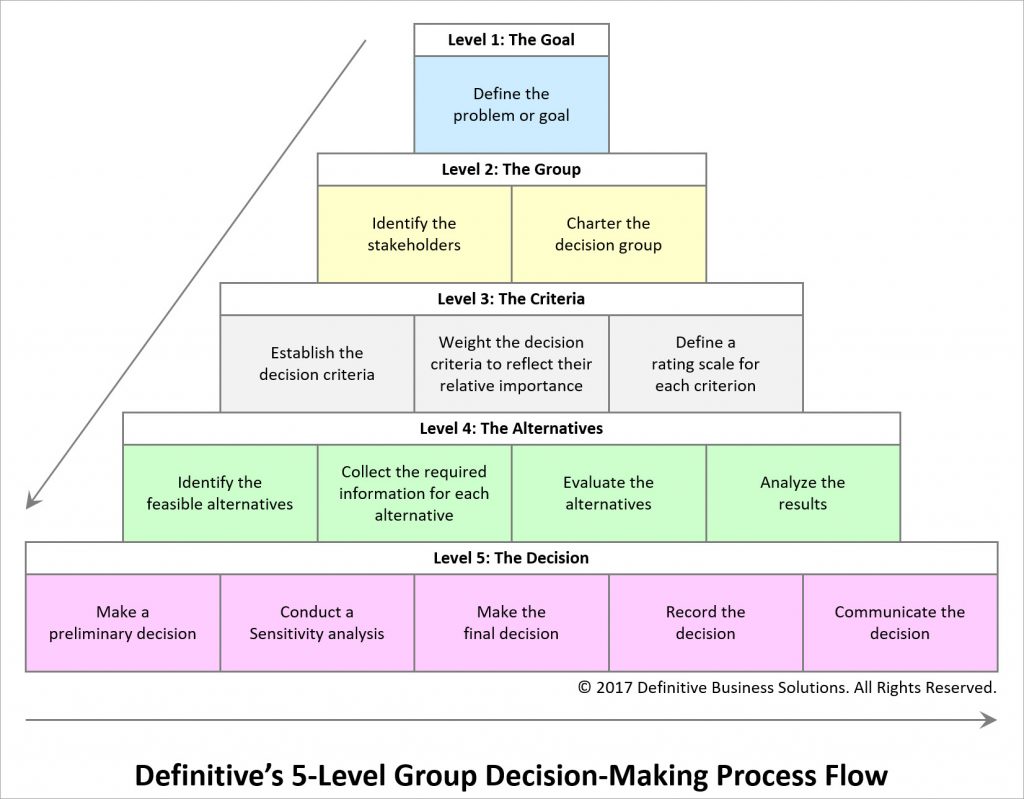New Research: Diversity + Inclusion = Better Decision Making At Work
September 28, 2017When Should Leaders Own a Decision and When Should They Delegate?
October 19, 2017Group Decision Support for Agency Budget Formulation

Over the last few years, the compliance-driven “slice of the budget pie” has grown considerably in government agencies. In the good ole days, we contended with the classic trade-off of how much should be spent on new initiatives and enhancements versus operations and maintenance (O&M). The more efficiency that we could achieve in O&M, the more financial and human resources would be available to do new things and address new mission needs.

Now, after decades of unyielding growth in laws and regulations and the ever-increasing and changing cyber-security threats, agencies are now faced with carving a larger portion of the budget pie for compliance-related initiatives. The 800-lb. compliance gorilla has a seat at the table and he has an insatiable appetite for pie. This places greater pressure on the budget and makes the need to prioritize competing projects and initiatives greater than ever.
Balancing the Competing Needs and Priorities of a Civilian Federal Agency
At one such federal agency, we have given first preference to O&M work, which is defined as primarily “keeping the lights on” and “break-fix”. That portion of the pie includes a significant amount of proactive O&M endeavors, such as technology refreshes, that need to be included to avoid outages and meet service level agreements. We then give second preference to compliance tasks, which come to us as external requirements from a host of sources (e.g., laws, regulations, departmental policy, OMB guidance, etc.).
Even through compliance-driven work is treated as a mandate, this portion of the pie still needs to be assessed and prioritized as there are a wide range of discretionary decisions that still need to be made on compliance requirements. For one, there are multiple alternatives and approaches to achieving compliance on most requirements, each with different costs, timelines, and risks, so they should be evaluated and prioritized a group of stakeholders.
In addition, everything can’t be done at once – so there is a risk exposure analysis to be performed to determine when compliance projects and initiatives can and should be started. This analysis is critical to ensuring that the compliance items presenting the most risk to the agency are getting the top priority.
Finally, after O&M and compliance needs have been planned for, the remainder of the budget is allocated to further enabling the business (i.e., fulfilling the mission). Here, the evaluation and prioritization process uses a decision model (which is the subject of my next blog) that includes weighted criteria, such as:
- Delivering new and enhanced end user capabilities
- Improving efficiency and effectiveness
- Enhancing the customer experience
- Increasing the quality of information, analytics, and reporting
Balancing the O&M, compliance, and business needs of a federal agency or any large enterprise requires working across functional lines using a structured and defined process that can handle multiple decision criteria, numerous stakeholders, and a lengthy list of alternatives (see our last blog, here).
Defining the Decision-Making Process and Making It Transparent
Defining the decision-making process is crucial to budget formulation and execution. Good leaders define, document, and publish their process for making decisions – particularly those of a recurring nature. They ensure the process conforms to existing governance policy, provides a foundation for standard operating procedures (SOPs), and lays the groundwork for potential process automation. By demystifying how decisions are made, the organization can better align its work so that it can feed into the decision-making process and minimize the amount of “decision swirl” that comes when a decision process is unknown, in flux, or does not have a finite beginning or an end. A well-communicated decision process is particularly necessary when the decisions being made require the support of others to implement.
A general decision-making process flow, such as the one below, can be tailored and integrated into an existing business process, and then published to the organization.

In the public sector, there is not only a business benefit to defining, documenting, and publishing processes for making decision, but also laws and regulations that require it. In state and local government, sunshine laws require openness in government or business, and make meetings, records, votes, deliberations and other official actions available for public observation, participation, and/or inspection. In federal government, the Freedom of Information Act (FOIA) grants the public access to information possessed by government agencies, unless it falls under one of nine exemptions listed in the Act.
Does your organization make budget formulation and execution decisions that are well-defined and transparent?
© 2017 Definitive Business Solutions. All Rights Reserved.
John Sammarco has thirty-five years of experience leading, managing, and consulting to top public and private sector organizations, and has over twenty years of experience in facilitating complex group decisions. John founded Definitive Business Solutions in 2003, which provides world-class group decision-making solutions to increase efficiency, boost ROI, and reduce risk associated with business and technology investments. In 2016, John developed Definitive Pro™, which helps groups build consensus and make multi-criteria decisions.


